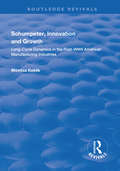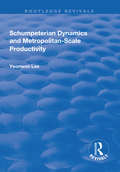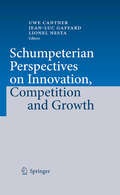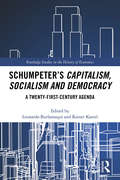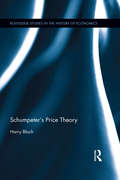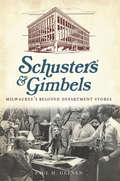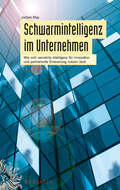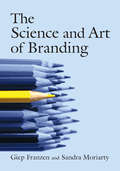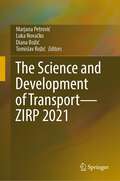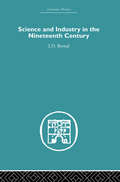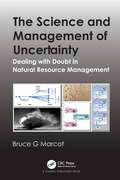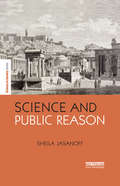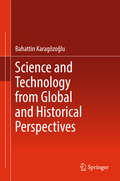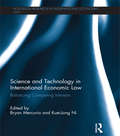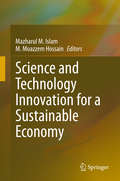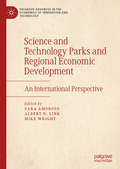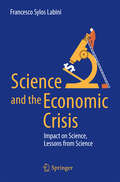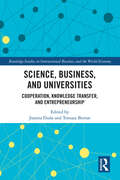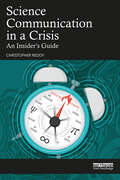- Table View
- List View
Schumpeter, Innovation and Growth: Long-Cycle Dynamics in the Post-WWII American Manufacturing Industries
by Mümtaz KeklikThis title was first published in 2003. Bringing together contemporary innovation pattern theories inspired by the two original patterns developed by Joseph A. Schumpeter, this book develops an innovative new model of long wave aggregate level economic activity. This model is rigorously tested with post-war US manufacturing data, revealing an intriguing correlation between the data and the model. The book examines different theories of technological change, and provides a detailed account of the long wave which makes use of the relevant aspects of these theories, without betraying their main features and messages. These theories are synthesized and shown to be consistent with the development of post-war US manufacturing. Shedding light on the dynamics of the technological advances that have taken place in the last 20 years, economists and students alike will find this volume an invaluable read.
Schumpeterian Analysis of Economic Catch-up
by Keun LeeOne of the puzzles about why some countries have stronger economic growth than others revolves around the so-called 'middle-income trap', the situation in which a country that has grown strongly gets stuck at a certain level. In this book, Keun Lee explores the reasons why examples of successful catching-up are limited and in particular, why the Asian economies, including China, have managed to move, or are moving, beyond middle-income status but economic growth has stalled in some Latin American countries. This is one of the first studies to demonstrate using patent analysis that the secret lies in innovative systems at the firm, sector and country levels which promote investment in what the author calls 'short-cycle' technologies and thereby create a new path different from that of forerunning countries. With its comprehensive policy framework for development as well as useful quantitative methods, this is essential reading for academic researchers and practitioners.
Schumpeterian Dynamics and Metropolitan-Scale Productivity (Routledge Revivals Ser.)
by Yeonwoo LeeThis title was first published in 2003. Schumpeter first put forward the premise that the incessant turbulence of an economy in motion, carrying out new combinations of products, production methods with new technologies and the opening of new markets, is capable of explaining patterns of economic growth and change. Focusing on US industrialized urban areas, this volume tests this theory empirically. Localized employment ’churn’ - registered as job creation/destruction dynamics - is used to account for variations in US metro-regional economic productivity performances during the 1986-1999 period. The results suggest that the employment turnover and replacement dynamics have large and significant positive effects on localized productivity growth independent of a variety of industrial restructuring processes occurring simultaneously. While employment churn effects are robust across US Census regions, they do not exert a uniform influence on metro-regional productivity performances across time. Until 1996, job creation and destruction dynamics often cancelled each other out as metro-regions underwent continued industrial restructuring. Since 1996, however, positive effects on metro-region productivity growth have been consistently strong. In addition to a strong positive effect on productivity of the emergence of a localized IT sector, both an expanding service sector share of regional employment and a rising public spending share of regional output exert powerful downward pressure of localized productivity growth rates.
Schumpeterian Perspectives on Innovation, Competition and Growth
by Uwe Cantner Lionel Nesta Jean-Luc GaffardRecent developments in economics have gone from the recognition of the importance of innovation for growth and the exploration of innovation mechanisms to the incorporation of the results of the previous research into economic models. An important lesson to be drawn from all this research is that a purely macro-based analysis of growth is not enough. The various mechanisms of innovation creation and diffusion, the importance of agent heterogeneity, of market selection processes, of the internal organization of the firm and of organizational routines, and the obsolescence and the consequent emergence of new types of capital goods are a few examples of micro-economic phenomena that contribute decisively to macro-economic development. The papers in this volume approach those issues from a Schumpeterian point of view and tackle issues like the growing importance of knowledge and human capital; increasing returns and path dependence; the role of variety in economic growth; competition and industry evolution.
Schumpeter’s Capitalism, Socialism and Democracy: A Twenty-First Century Agenda (Routledge Studies in the History of Economics)
by Leonardo Burlamaqui Rainer Kattel2017 marked the seventy-fifth anniversary of Schumpeter’s Capitalism, Socialism and Democracy, a work acknowledged as one of the most insightful books written in the twentieth century. It retains a contemporary quality, and still invites criticisms, new interpretations, and extensions and across disciplines. This book, in addition to re-examining Schumpeter’s seminal work and undertaking a twenty-first-century update of its main themes, brings together leading social scientists to provide contemporary amendments, extensions – or eventually refutations – of key elements of Schumpeter’s vision and thesis. Issues covered include a new take on creative destruction, the contours of a theory of innovative enterprise, finance and financialisation, a critique of the secular stagnation thesis, Schumpeter’s contributions to a theory of the entrepreneurial state, his conception of socialism and its current relevance for understanding the 'China model' as well as a rekindling of his democracy thesis for our times. Bringing together leading international contributors, this book provides fresh perspectives on ideas that continue to be hugely relevant to contemporary social sciences and a guide for understanding the current tensions among capitalism, the state and democracy. These chapters will be of interest to economists, social scientists and anyone with an interest in modern capitalism.
Schumpeter's Price Theory (Routledge Studies in the History of Economics)
by Harry BlochJoseph Alois Schumpeter has long been recognised as one of the great economists of the 20th Century, and his truly revolutionary approach to economic development continues to gain appreciation. This is particularly due to the emphasis he places on innovation and creative destruction as drivers of economic development. Yet, aspects of his theory remain neglected and poorly understood, especially his treatment of prices and price dynamics. This book provides a comprehensive and critical examination of Schumpeter’s price theory as well as providing suggestions for the further development of the theory. While Schumpeter’s theories of economic development, entrepreneurship and the business cycle have received substantial attention in the literature, his price theory has been neglected. Yet, he proposes a price theory that is as radical as his treatment of other topics. The holistic nature of his theory also naturally means that a better understanding of his price theory will provide extra insight into other aspects of his theoretical framework. This volume is of great interest to those who study Schumpeter’s work, as well as those who have an interest in history of economic thought, economic theory and philosophy and political economy.
Schuster's & Gimbels: Milwaukee's Beloved Department Stores (Landmarks)
by Paul GeenenA nostalgic journey into the life of these Wisconsin shopping meccas—including photos and illustrations. For well over a century, Milwaukee shoppers have had Gimbels or Schuster&’s in their lives. Even if they didn&’t crave sewing notions or prize-winning apple pies, they were watching holiday parades wind by, tuning in for Billie the Brownie&’s radio updates, or losing themselves in front of one of the department stores&’ fabulous window displays. Not only were they magical places to shop but also wonderful places to work, creating the kind of community where a kid might come in to help out with the Christmas rush and stay for twenty-five years. Enjoy this loving trip through the history of these beloved stores, from their arrival in Milwaukee in the 1880s through the 1962 merger and beyond.
Schutz genetischer, medizinischer und sozialer Daten als multidisziplinäre Aufgabe
by Stefan Katzenbeisser Kay Hamacher Heribert M. AnzingerFortschritte in der Medizin, in der Genomforschung und in der Informationstechnik stellen den Datenschutz vor ein Dilemma: Forschung und die Anwendung neuer Methoden setzen häufig voraus, dass personenbezogene Daten in großem Umfang zentral verfügbar, verteilbar und verknüpfbar sind. Gleichzeitig bergen zentrale Datensammlungen und die unübersehbare Weitergabe und Verknüpfung sensitiver Daten die Gefahr, dass der Einzelne auf ein Datenraster reduziert wird und Selbstbestimmungsmöglichkeiten verliert. Den Wertungskonflikten und der Schutzbedürftigkeit und Schutzfähigkeit personenbezogener genetischer, medizinischer und sozialer Daten widmete sich eine multidisziplinäre Veranstaltungsreihe des Center for Advanced Security Research Darmstadt, der Darmstädter Juristischen Gesellschaft und der Fakultät für Rechts- und Wirtschaftswissenschaften der Technischen Universität Darmstadt. Der vorliegende Band fasst die dabei entwickelten Gedanken verschiedener Wissenschaftsdisziplinen zusammen.
Schutzkonzepte gegen sexualisierte Gewalt in medizinischen Einrichtungen für Kinder und Jugendliche
by Marc Allroggen Jörg M. Fegert Elisa König Miriam Rassenhofer Ulrike HoffmannMedizinische Einrichtungen sind Orte, die der Pflege bei und Behandlung von Erkrankungen dienen, an denen es aber auch zu Gewalt und Vernachlässigung gegen Patientinnen und Patienten kommen kann. Seit November 2020 ist es deshalb aufgrund einer Vorgabe des Gemeinsamen Bundesausschusses (G-BA) für medizinische Einrichtungen verpflichtend, ein Schutzkonzept gegen (sexualisierte) Gewalt zu entwickeln. Für die Entwicklung von Schutzkonzepten im medizinisch-therapeutischen Bereich gab es bisher kaum umfassende Handreichungen. Das vorliegende Buch schließt diese Lücke: Die Autorinnen und Autoren gehen zunächst auf die spezifischen Merkmale des medizinisch-therapeutischen Arbeitskontextes ein und geben generelle Hinweise zur Entwicklung von Schutzkonzepten. Anschließend stellen sie die Elemente eines Schutzkonzeptes vor und geben praxisnahe Empfehlungen für dessen Entwicklung, Umsetzung und Evaluation. Zu jedem Element regen ergänzende Arbeitsblätter mit Übungen und Reflexionen zur Umsetzung in der eigenen Institution an. Darüber hinaus werden jeweils auch Hinweise zur Adaption an verschiedene Settings gegeben: den kinder- und jugendpsychiatrischen und somatischen Bereich, stationäre oder ambulante Strukturen sowie die Übertragung auf andere Zielgruppen (z.B. die Betreuung von Menschen mit Behinderung). Darstellungen von Schutzprozessen in verschiedenen Kliniken machen als Praxisbeispiele deutlich, dass es nicht den einen “Königsweg” zum Schutzkonzept gibt.Das Buch versteht sich als Praxishandbuch und richtet sich an Ärztinnen und Ärzte, Therapeutinnen und Therapeuten sowie alle anderen Fachkräfte im medizinisch-therapeutischen Bereich, die Schutzmaßnahmen entwickeln möchten - damit Kliniken und Praxen Schutzorte bleiben, statt zum Tatort zu werden.
Schwarmintelligenz im Unternehmen: Wie sich vernetzte Intelligenz für Innovation und permanente Erneuerung nutzen lässt
by Jochen May"Der Autor zeigt nicht nur auf, wie sich Schwarmintelligenz entfaltet, er gibt auch ein praxisnahes Konzept für ihre gelungenen Umsetzung im Arbeitsalltag - klar durchdacht und prägnant ausformuliert." Michael Best, Hessischer Rundfunk, ARD-Börsenredaktion Schwarmintelligenz fasziniert durch erstaunliche Ergebnisse - doch kaum ein Unternehmen hat bisher ihr außergewöhnliches Potenzial entdeckt, geschweige denn von ihr profitiert. Erst ganz allmählich gerät Schwarmintelligenz ins Blickfeld neugieriger Führungskräfte. Das liegt sicher auch daran, dass innerbetriebliche Führungsinstrumente zur Aktivierung von Schwarmintelligenz bis dato nicht zur Verfügung standen. Schwarmintelligenz beruht auf geschickter Vernetzung unterschiedlicher Kompetenzen der Schwarmmitglieder. Komplexe Sachverhalte erscheinen unter vielen Blickwinkeln und werden dadurch treffender erfasst. Entrepreneurship hält Einzug, MitarbeiterInnen erproben das Neue. Der Innovationsdruck von außen wird durch einen inneren Innovationsmotor ergänzt. Leistungen gelingen kundengerechter, die Arbeitseffizienz steigt, Reaktionszeiten verkürzen sich. Reibungsverluste werden eliminiert, Bürokratie und Verwaltungsmentalität nehmen ab. Dieses Buch stellt - zum Teil erstmalig und exklusiv - die für den betrieblichen Einsatz von Schwarmintelligenz erforderlichen Führungsinstrumente vor. Es untersucht Vorteile und Wirkungsweise von Schwarmintelligenz und weist einen leicht gangbaren, praxisorientierten Weg, Schwarmintelligenz erfolgreich in Unternehmen einzubinden. Die Techniken und Methoden sind umfassend beschrieben und erlauben es, kontinuierliche Innovation durch Schwarmintelligenz im Arbeitsalltag sofort und unkompliziert umzusetzen. Für Führungskräfte aller Ebenen und Fachrichtungen ist das Buch ein Muss, aber auch für Nachwuchskräfte und alle MitarbeiterInnen, die zukunftsorientiert verändern wollen.
Schwellenkonzeptorientierte Entrepreneurship Education: Ein wirtschaftsdidaktischer Ansatz unter Berücksichtigung komplexitätswissenschaftlicher Theorien und Methoden (Komplexität, Entrepreneurship und Ökonomische Bildung)
by Jan-Martin GeigerEntrepreneurship Education gewinnt nach wie vor an Bedeutung innerhalb der Bildungslandschaft, allen voran an Schulen und Hochschulen. Vor diesem Hintergrund besteht ein dringender Bedarf an konzeptionellen Überlegungen, die auf lerntheoretische und didaktische Fragestellungen zielen und sowohl die Theorie- als auch die Praxisebene von Entrepreneurship Education bereichern sollen. Die vorliegende Arbeit entwickelt unter Einbezug des Schwellenkonzeptansatzes eine neue Perspektive für eine wirtschaftsdidaktisch gedachte Entrepreneurship Education, die disziplinäre Phänomene mit der subjektiven Sichtweise Lernender zunächst auf theoretischer Ebene verbindet und anschließend anhand von eigens entwickelten Lernstudien empirisch untersucht.
Schwierige Situationen im Business-Coaching: Praxisbeispiele, Perspektiven und Handlungsmöglichkeiten
by Heidi Möller Jannik ZimmermannCoaches begegnen in ihrer beruflichen Praxis einer Bandbreite von Situationen, die sie als schwierig erleben. Die Herausforderungen haben unterschiedliche Quellen. Sie können von den Coaches selbst, den Coachees oder der beauftragenden Organisation ausgehen. Doch wie stellen sich diese Situationen im Detail dar? Wie kann man als Coach diese verstehen und angemessen darauf reagieren? Anhand online erhobener realer Fallbeispiele werden in diesem Buch schwierige Situationen genauer betrachtet. Hierbei stellen renommierte Coaches ihre theoretischen und methodischen Perspektiven und ihre Handlungsempfehlungen zur Diskussion.
The Science and Art of Branding
by Giep Franzen Sandra E. MoriartyThis innovative work provides a state-of-the-art overview of current thinking about the development of brand strategy. Unlike other books on branding, it approaches successful brand strategy from both the producer and consumer perspectives. "The Science and Art of Branding" makes clear distinctions among the producer's intentions, external brand realities, and consumer's brand perceptions - and explains how to fit them all together to build successful brands. Co-author Sandra Moriarty is also the author of the leading Principles of Advertising textbook, and she and Giep Franzen have filled this volume with practical learning tools for scholars and students of marketing and marketing communications, as well as actual brand managers. The book explains theoretical concepts and illustrates them with real-life examples that include case studies and findings from large-scale market research. Every chapter opens with a mini-case history, and boxed inserts featuring quotes from experts appear throughout the book. "The Science and Art of Branding" also goes much more deeply than other works into the core concept of brand equity, employing new measurement systems only developed over the last few years.
The Science and Development of Transport—ZIRP 2021
by Marjana Petrović Luka Novačko Diana Božić Tomislav RožićThis monograph presents the original scientific manuscripts submitted for publication at the International Conference - The Science and Development of Transport (ZIRP 2021), organized by the University of Zagreb, Faculty of Transport and Traffic Sciences, Zagreb, Croatia. The Conference takes place in Šibenik, Croatia, from 30th September until 1st October 2021, aiming to bring together the scientists and the practitioners by putting forward innovative solutions available to everyone. This monograph presents the newest scientific research, case studies, and best practices in the field of transport and logistics. In addition to the main topics, many relevant manuscripts in the field of transport and logistics have been presented, such as sustainable urban mobility and logistics, safety and policy, data science, process automation, inventory forecasting, improving competitiveness in the transport and logistics services market and raising customer satisfaction. The monograph will be of interest for the experienced researchers, professionals as well as Ph.D. students in the field of transport and logistics
Science and Industry in the Nineteenth Century
by J.D. BernalPublished in 2005, Science and Industry in the Nineteenth Century is a valuable contribution to the field of Economic History.
The Science and Management of Uncertainty: Dealing with Doubt in Natural Resource Management
by Bruce G. MarcotUncertainty can take many forms, can be represented in many ways, and can have important implications in decision-making and policy development. This book provides a rigorous scientific framework for dealing with uncertainty in real-world situations, and provides a comprehensive study of concepts, measurements, and applications of uncertainty in ecological modeling and natural resource management. The focus of this book is on the kinds and implications of uncertainty in environmental modeling and management, with practical guidelines and examples for successful modeling and risk analysis in the face of uncertain conditions and incomplete information. Provided is a clear classification of uncertainty; methods for measuring, modeling, and communicating uncertainty; practical guidelines for capturing and representing expert knowledge and judgment; explanations of the role of uncertainty in decision-making; a guideline to avoiding logical fallacies when dealing with uncertainty; and several example cases of real-world ecological modeling and risk analysis to illustrate the concepts and approaches. Case topics provide examples of structured decision-making, statistical modeling, and related topics. A summary provides practical next steps that the reader can take in analyzing and interpreting uncertainty in real-world situations. Also provided is a glossary and a suite of references.
Science and Public Reason (The Earthscan Science in Society Series)
by Sheila JasanoffThis collection of essays by Sheila Jasanoff explores how democratic governments construct public reason, that is, the forms of evidence and argument used in making state decisions accountable to citizens. The term public reason as used here is not simply a matter of deploying principled arguments that respect the norms of democratic deliberation. Jasanoff investigates what states do in practice when they claim to be reasoning in the public interest. Reason, from this perspective, comprises the institutional practices, discourses, techniques and instruments through which governments claim legitimacy in an era of potentially unbounded risks—physical, political, and moral. Those legitimating efforts, in turn, depend on citizens’ acceptance of the forms of reasoning that governments offer. Included here therefore is an inquiry into the conditions that lead citizens of democratic societies to accept policy justification as being reasonable. These modes of public knowing, or “civic epistemologies,” are integral to the constitution of contemporary political cultures. Methodologically, the book is grounded in the field of Science and Technology Studies (STS). It uses in-depth qualitative studies of legal and political practices to shed light on divergent cross-cultural constructions of public reason and the reasoning political subject. The collection as a whole contributes to democratic theory, legal studies, comparative politics, geography, and ethnographies of modernity, as well as STS.
Science and Technology from Global and Historical Perspectives
by Bahattin KaragözoğluThis book provides science and technology ethos to a literate person. It starts with a rather detailed treatment of basic concepts in human values, educational status and domains of education, development of science and technology and their contributions to the welfare of society. It describes ways and means of scientific progresses and technological advancements with their historical perspectives including scientific viewpoints of contributing scientists and technologists. The technical, social, and cultural dimensions are surveyed in relation to acquisition and application of science, and advantages and hindrances of technological developments. Science and Technology is currently taught as a college course in many universities with the intention to introduce topics from a global historical perspective so that the reader shall stretch his/her vision by mapping the past to the future. The book can also serve as a primary reference for such courses.
Science and Technology in International Economic Law: Balancing Competing Interests (Routledge Research in International Economic Law)
by Bryan Mercurio Kuei-Jung NiScience and technology plays an increasingly important role in the continued development of international economic law. This book brings together well-known and rising scholars to explore the status and interaction of science, technology and international economic law. The book reviews the place of science and technology in the development of international economic law with a view to ensure a balance between the promotion of trade and investment liberalisation and decision-making based on a sound scientific process without hampering technological development. The book features chapters from a range of experts – including Lukasz Gruszczynski, Jürgen Kurtz, Andrew Mitchell and Peter K. Yu – who examine a wide range of issues such as investment law, international trade law, and international intellectual property. By bringing together these issues, the book asks how international trade and investment regimes utilise science and technology, and whether they do so fairly and in the interest of broader public policies. This book will be of great interest to researchers of international economic law, health law, technology law and international intellectual property law.
Science and Technology Innovation for a Sustainable Economy
by Mazharul M. Islam M. Moazzem HossainThis book discusses the subject of pathways to a sustainable economy through science and technology innovations which are regarded as the important components of the ‘4th Industrial Revolution’. The volume has been developed from Bangladesh’s ‘Vision 2041’ agenda which includes development actions needed to catch up with more developed nations. Most importantly, the goals of the ‘Vision 2041’ have been taken from the dreams of the architect of independent Bangladesh, Bangabandhu (Friends of Bengal) Sheikh Mujibur Rahman. His dream was to make Bangladesh the Switzerland of Asia. The Father of Bangladesh Nation was killed by assassins’ bullets along with his most of the family members in August 1975. After his death, the nation moved backwards while recovering from nine months of liberation post war in 1971.Between 1975 and 1990 Bangladesh was ruled by military and quasi military governments. Bangladesh established a true democratic regime in 1996 with Sheikh Mujib’s daughter, Sheikh Hasina, who formed the government after 21 years with a mandate to realise the dreams of her father. Sheikh Hasina, had her own 20 year vision for Bangladesh, called, ‘Vision 2021’, with plans to make the nation poverty free by 2021. After a pause between 2001 and 2008, Sheikh Hasina returned to power in 2009. Under her consecutive three terms she brought Bangladesh back on track and Bangladesh is one of the nations which reduced poverty half under MDGs by 2015. During her third consecutive term Sheikh Hasina, is on the way to transforming Bangladesh into a ‘middle income’ nation by 2021. This volume aims to identify and mitigate the challenges of ‘4th Industrial Revolution’ investigating the areas of science and technology innovations for Bangladesh and for other parts of the world keeping in mind establishing a sustainable economy under UN agendas to 2030 (SDGs). The primary audience for this book are UN development agencies, academic institutions, government policymakers and business leaders of the more developed and developing nations alike.
Science and Technology Parks and Regional Economic Development: An International Perspective (Palgrave Advances in the Economics of Innovation and Technology)
by Sara Amoroso Albert N. Link Mike WrightThis book is the first collection of scholarly writings on science and technology parks (STPs) that has an international perspective. It explores concrete ways to systematically collect information on public and private organizations related to their support of and activities in STPs, including incubation to start-up and scale-up, and collaborations with centers of knowledge creation. Rather than perpetuate the qualitative assessment of successful practices, the focus of this book is to present quantitative and qualitative evidence of the impact of STPs on regional development and to raise awareness on the importance of systematic data collection and analysis. Only through a systematic collection of data on fiscal identification numbers of companies, universities, and university spin-offs will it be possible to conduct current and especially future analyses on the impact of STPs on entrepreneurship, effectiveness of technology transfer, and regional economic development. To this extent, the synergistic views of academics, representatives from STPs, and policy experts are crucial.
Science and the Economic Crisis
by Francesco Sylos LabiniThis book not only explores the ways in which theeconomic crisis and associated austerity policies have adversely impacted thephysical and human infrastructure and conduct of scientific research, but alsoconsiders how science can help us to understand the crisis and provide originalsolutions. Starting with a detailed but accessible analysis of the scientificmethod and the nature of scientific prediction, the book proceeds to addressthe failure to forecast the economic crisis and the origins of the continuinginertia in economic policy and theory. Attention is drawn in particular to theshortcomings of neoclassical economics in terms of its description of theeconomic system as being mechanical in nature and characterized by equilibrium. This perspective mirrors the limitations and outdated ideas of nineteenthcentury physics, which the book contrasts with the insights offered by modernphysics. The impact of neoliberal ideologies on scientific research is alsodiscussed in detail, highlighting their stifling effect on innovation anddiversification. In closing, the book emphasizes the need for stateintervention to guide and support scientific research as the core engine ofeconomic development that will deliver a sustainable future.
The Science-Based Business: A Novel Experiment
by Gary P. PisanoFor more than twenty-five years, the biotechnology industry has been host to a profound and important experiment: the fusion of science and business. The significant challenges of integrating science and business have driven this sector to pursue novel organizational and institutional experiments that encompass various forms of collaboration between firms, business models for capturing value from innovation, definitions of what constitutes intellectual property, contractual arrangements to "monetize" intellectual property, the "rules" by which academic institutions and private companies interact, and the boundaries delineating private versus government research. This chapter offers a brief history of this experiment and outlines the major challenges facing the science-as-business industry.
Science, Business and Universities: Cooperation, Knowledge Transfer and Entrepreneurship (Routledge Studies in International Business and the World Economy)
by Joanna Duda Tomasz BernatCooperation between science and business (S2B cooperation) is a very important issue from the points of view of the domestic economy, companies, and universities. This is mainly because such cooperation is a catalyst for faster and reliable development – not only of enterprises, but also of the entire economy. Thanks to S2B cooperation, enterprises can gain and commercialize new and ground-breaking solutions. Universities in turn can give their research a more practical dimension to increase its economic applicability, which helps universities prepare future staff to work in modern enterprises. The aim of this publication is to indicate how cooperation between universities and business can be implemented in an international dimension. It shows the role of modern universities in supporting the development of enterprise and entire economies as well as the role of modern enterprises that use resources located in universities (including knowledge resources). This unique combination has a positive impact on the results and developmental opportunities for each of them. Any potential obtained in this manner is the basis for creating a competitive advantage on the market. This book is devoted to a specific area of cooperation between enterprises and universities and will be of interest to researchers, academics, practitioners, and students in the fields of entrepreneurship, knowledge management, international relations, and higher education.
Science Communication in a Crisis: An Insider's Guide
by Christopher ReddyScience Communication in a Crisis: An Insider’s Guide identifies the principal challenges that scientists face when communicating with different stakeholder groups and offers advice on how to navigate the maze of competing interests and deliver actionable science when the clock is ticking. If a scientist’s goal is to deliver content and expertise to the people who need it, then other stakeholder groups—the media, the government, industry—need to be considered as partners to collaborate with in order to solve problems. Written by established scientist Christopher Reddy, who has been on the front lines of several environmental crisis events, the book highlights ten specific challenges and reflects on mistakes made and lessons learned. Reddy’s aim is not to teach scientists how to ace an interview or craft a soundbite, rather, through exploring several high-profile case studies, including the North Cape oil spill, Deepwater Horizon, and the 2021 Sri Lanka shipping disaster, he presents a clear pathway to effective and collaborative communication. This book will be a great resource for junior and established scientists who want to make an impact, as well as students in courses such as environmental and science communication.
